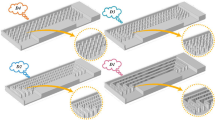Abstract
The use of thermochromic liquid crystal technique (LCT) and true-colour image processing system in heat transfer modelling is described. Experimental procedure, led on rig at Technical University of Gdansk, cover full-field flow patterns in heat exchanger element (flat plate with fine-tubes in-line, staggered and with vortex generators) describing local heat transfer coefficient and Nusselt number on the surfaces. Also the dependence of average heat transfer and pressure drop on Reynolds number and geometrical parameters is investigated.
Similar content being viewed by others
Abbreviations
- H :
-
height of the channel [m]
- k a :
-
conductivity of the air [W/m K]
- k t :
-
mean conductivity of the liquid crystal package and plate [W/m K]
- L :
-
the length of the channel in the main flow direction [m]
- ΔP :
-
pressure drop [Pa]
- r i :
-
Hue ratio coefficient (ratio of number of pixels for the hue range considered) [—]
- T a :
-
temperature of air [K]
- T b :
-
temperature of plate on waterside [K]
- T l :
-
temperature of surface (liquid crystal yellow-green isotherm temperature) [K]
- U :
-
inlet mean velocity [m/s]
- δ:
-
thickness of the liquid crystal package and plate [m]
- σ:
-
air density [kg/m3]
- ν:
-
viscosity of air [m2/s]
References
Baughn, J. W. and Yan, X., Liquid Crystal Methods in Experimental Heat Transfer, Proceedings of 32nd Heat Transfer and Fluid Conference, (1991), 15–40.
Data Translation Inc.: Image Processing Handbook, (1991).
Hollingsworth, D. K., Boehman, A. L., Smith, E. G. and Moffat, R. J., Measurement of Temperature and Heat Transfer Coefficient Distributions in a Complex Flow Using Liquid Crystal Thermography and True-Colour Image Processing, ASME Heat Transfer, 123 (1989), 35–42.
Jones, T. V., Wang, Z. and Ireland P.T., The Use of Liquid Crystals in Aerodynamic and Heat Transfer Experiments, Proceedings of 1st ImechE Seminar on Optical Methods and Data Processing in Heat and Fluid Flow, (1992), 55–65.
Moffat, R. J., Experimental Heat Transfer, Proceedings of the 9th International Heat Transfer Conference, 1, (1991), 308–310.
Stasiek, J. A., Experimental Studies of Heat Transfer and Fluid Flow across Corrugated-undulated Heat Exchanger Surfaces, Int. J. Heat Mass Transfer, 41-6 and 7 (1998), 899–914.
Stasiek, J. and Collins, M. W., The Use of Liquid Crystals and True-Colour Image Processing in Heat and Fluid Flow Experiments, Atlas of Visualization, Vol. 2 (1996), CRC Press, U.S.A.
Wierzbowski, M., Barański, J. and Stasiek J., Local Heat Transfer Measurement in Heat Exchanger Elements. X Symposium of Heat and Mass Transfer, Vol. II, (1998), 868–874.
Author information
Authors and Affiliations
Additional information
Maciej Wierzbowski: He received his M.Sc. degree in Mechanical Engineering in the field of ventilation and airconditioning systems in 1995 at the Technical University of Gdansk. He works at the Technical University of Gdansk as Assistant Lecturer and is about to complete his Ph.D. studies. He was taking opportunities to take scholarships at City University of London, Ruhr-University of Bochum (Germany) and University of Palermo (Italy). He will present his Ph.D. thesis in April 2002 in heat transfer and liquid crystal imaging. His research interest includes heat and mass transfer, fluid flows and visualization of phenomena using imaging techniques.
Jan Antoni Stasiek: He received his M.Sc. degree in Mechanical Engineering in 1972 at the Technical University of Gdansk as well as his Ph.D. in 1975. He also received his D.Sc. Degree at the Technical University of Gdansk in the area of complex radiation. He went for a long-term scientific training to the City University in London, where he acted as Visiting Professor. Scientific achievements resulted in the second Ph.D. thesis presented in London in 1992 in area of liquid crystal implementation in heat transfer experiments, and D.Sc. dissertation in 1995 with analytical, numerical and experimental methods for combined radiation and convection heat transfer, thermal technology and some related problems. Both titles have been awarded by the City University of London. He received the title of full professor in 1998. He works at the Technical University of Gdansk, acting as Head of Department of Heat Technology at Faculty of Mechanical Engineering. Research activities: thermodynamics, heat and fluid flow, thermal technology, highly preheated air combustion, modelling and analysis of heat and fluid flow in complex geometries, application of liquid crystals and true-colour image processing in heat and fluid flow problems, theoretical and experimental investigation of high temperature gasification and combustion, radiation heat transfer, two-phase flows, renewable energy sources.
Rights and permissions
About this article
Cite this article
Wierzbowski, M., Stasiek, J. Liquid crystal technique application for heat transfer investigation in a fin-tube heat exchanger element. J Vis 5, 161–168 (2002). https://doi.org/10.1007/BF03182425
Received:
Revised:
Issue Date:
DOI: https://doi.org/10.1007/BF03182425




